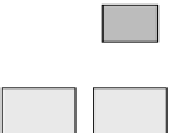Image Processing Reference
In-Depth Information
quickly than in nodes that are operating properly, even when sporadic errors are considered caused
by electromagnetic noise.
When one of the error counters exceeds a first threshold (), the node is switched to the error
passive state, so as to try not to affect the network. It will return to the error active state as soon as
counters fall below the above threshold. When a second threshold () is exceeded, instead, the node
is switched to the bus-off state. At this point, it can no longer transmit any frame on the network, and
it can be switched back to the error-active state only after it has been reset and reconfigured.
15.2.6 Communication Services
According to the ISO specification [ISO], the LLC sublayer of CAN provides two communication
services only:
L_DATA
, which is used to broadcast the value of a specific object over the network,
and
L_REMOTE
, which is used to ask for the value of a specific object to be broadcast by its remote
producer. From a practical point of view, these primitives are implemented directly in the h/w by all
the currently available CAN controllers.
15.2.6.1 Model for Information Exchanges
Unlike most network protocols conceived for the use in automated manufacturing environments
(which rely on node addressing) CAN adopts object addressing. In other words, messages are not
tagged with the address of the destination and/or originating nodes. Instead, each piece of informa-
tion that is exchanged over the network (often referred to as an object) is assigned a unique identifier,
which denotes unambiguously the meaning of the object itself in the whole system.
This fact has important consequences on the way communications are carried out in CAN. In fact,
identifying objects that are exchanged over the network according to their meaning rather than to
the node they are intended for, allow implicit multicasting and makes it very easy for the control
applications to manage interactions among devices according to the producer/consumer paradigm.
The exchange of information in CAN takes place according to the three phases shown in
Figure .:
. Producer of a given piece of information encodes and transmits the related frame
on the bus (the arbitration technique will transparently resolve any contention which
could occur).
Node A
(consumer)
Node B
(producer)
Node C
(other)
Node D
(consumer)
Device logic
Device logic
Device logic
Device logic
3a
3a
1
3b
Filter
Filter
Filter
Filter
Output
buffer
Input
buffer
Output
buffer
Input
buffer
Output
buffer
Input
buffer
Output
buffer
Input
buffer
CAN bus
2
FIGURE .
Producer/consumer model.




























































































